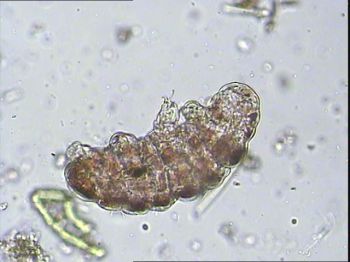World's toughest creatures should be used to inspire love of science in school pupils
By:
Last updated: Friday, 8 September 2017

Tardigrades captured under the microscope at the University of Sussex found in moss collected from Professor Jonathan Bacon's home
The world’s hardiest creatures should be used to stir up a love for biological discovery among school pupils, a University of Sussex academic has said.
Tardigrades, also known as space bears or moss piglets, can survive temperatures between 1500C and absolute zero, pressures seven times that found at the bottom of the world’s deepest ocean, and the frozen vacuum of space.
Professor Jonathan Bacon believes schools are missing a massive trick in not using these eight-legged micro-organisms, which can be found all over the world from the moss on a English suburban home to the icy tundra of Antarctica, to help instill a passion in biology and microscopy among school pupils.
The observation of these creatures, which can survive for up to 30 years without water in a suspended state known as a tun, in a microscopy practical forms part of Professor Bacon’s early module for new intakes of first-year students.
It follows surveys which show that less than a third of biology, ecology and other life sciences undergraduates have actually seen a living organism under a microscope by the time they reach university.
Prof Bacon said: “Tardigrades should be used in schools far more than they are as a fantastic gateway tool to get young people excited about science. It would be very easy to do, all you need is a bit of moss.
“They are a wonderful teaching resource, exploring their molecular make-up will help us discover the key to their incredible survival abilities.
“Most of the students have used microscopes before but mainly only to look at dead matter like onion root tip when instead teachers could be taking a piece of moss, adding water and then waiting for incredible creatures like tardigrades to appear. They can do what most lifeforms cannot do, and come to life again and students find this absolutely fascinating.”
A British Science Festival event this Saturday at the Jubilee Library, Brighton, will give ordinary members of the public the chance to see the hardy tardigrades.
Professor Bacon runs a final-year project for third-year students thinking of becoming secondary school science teachers where they spend one term studying microscopic animals in depth, with the aim of developing new practical microscope demonstrations to accompany GCSE and A-level biology teaching, which are then trialed in local secondary schools.
A recent academic article by Professor Bacon and his PhD student Harry Kent details how they have developed a cost-effective DIY digital microscope, using a small credit-card-sized computer called Raspberry Pi, which can be built and used in schools for around £50.
The professor and his graduates have been working on an outreach programme to introduce the wonders of microscopy to local schoolchildren, and in particular pupils from disadvantaged backgrounds.
University of Sussex PhD student Harry Kent said: “We know that schools are being impacted by cuts to their budgets, which is why we have been trying to develop a low-cost microscope which pupils can build and use.
“The largest tardigrade ever recorded was about 1.2 mm but most appear as just a fleck of dust to the naked eye. Under the microscope, they become the most amazing creatures to look at.
“Studying tardigrades could have very real benefits for human beings. Recent research in Japan identified a tardigrade protein which protects DNA from X-ray and desiccation damage, which could eventually be used to protect patients undergoing radiation therapy.”
Tardigrades: the toughest animals alive? will be held as part of the British Science Festival at the Jubilee Library in Brighton from 1.30 to 3:30pm on Saturday.

